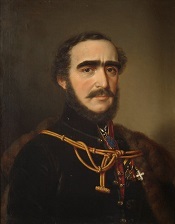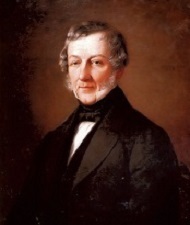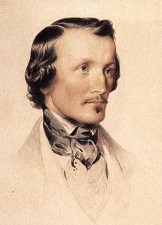
Budapest hídjai
Széchenyi Lánchíd
A Lánchíd volt az első Pestet és Budát összekötő állandő kőhíd, és csupán a második állandó átkelő a Duna teljes hosszában. Budapest egyik szimbolikus épülete, a magyar főváros legismertebb hídja.
Építését gróf Széchenyi István, a 18. századi Magyarország egyik vezéralakja javasolta. Hivatalos neve Széchenyi Lánchíd. A munkálatokat 1839-ben kezdték meg William Tierney Clark angol mérnök tervei alapján báró Sina György bécsi mecénás anyagi támogatásával. Az építkezést Adam Clark skót mérnök irányította, aki később egy magyar lányt vett feleségül és Magyarországon telepedett le. Róla nevezték el a híd budai hídfőjénél lévő teret. A Lánchíd felavatására 1849. november 20-án került sor.

Count István Széchenyi
(1791-1860) |

William Tierney Clark
(1783-1852) |

Adam Clark
(1811-1866) |
A Lánchíd építésekor a világ második legnagyobb fesztávú függőhídja volt. A hídfőket oroszlán alakú szobrok és Magyarország koronás címere és levélkoszorú díszíti. A mindkét pillérnél található kőoroszlánokat Marschalkó János szobrászművész faragta. Ezek azonban csak 1852-ben foglalták el a kijelölt helyeiket. A budai oldalon talapzatukon a Széchenyi és Sina családok Gál András által öntött címere is megtalálható. Szerencsére túlélték a második világháború pusztítását. Budapesten elterjedt városi legenda, hogy a Lánchíd oroszlánjainak nincs nyelvük. A legendából hiányzik a tényalap, az oroszlánoknak nagyon is van nyelvük, de ezek csak felülről láthatók.
A második világháború végén a visszavonuló német csapatok 1945. január 18-án felrobbantották Budapest összes hidaját, köztük a Lánchidat is. A híd szinte teljesen megsemmisült, csak a pillérei maradtak meg. Újjáépítéséről 1947 tavaszán döntöttek. Megkezdődtek az építési munkálatok: a pillérportálokat bővítették, kiszélesítették a pilléreket, lebontották a vámházakat, a budai végében gyalogos aluljárót építettek, Pesten pedig elkészült a villamos aluljáró. A város egyik leghíresebb épületét 1949. november 20-án, pontosan száz évvel az első avatás után végre birtokba vehették a budapestiek.

Amennyiben szeretnéd logolni a virtuális ládát, teljesítsd az alábbi feladatot.
Készíts egy fényképet legalább három budapesti hídon vagy közvetlenül a híd előtt, ami bizonyítja, hogy ott jártál (szelfi, GPS, nickneved egy papíron stb.). Nem elegendő az olyan fénykép, amin a a híd csak a távolban látható, a láda megtalálásához járnod kell legalább három budapesti hídon.

Bridges of Budapest
Chain Bridge
The Chain Bridge was the first permanent stone-bridge connecting Pest and Buda, and only the second permanent crossing on the whole length of the river Danube. It is one of the symbolic buildings of Budapest, the most widely known bridge of the Hungarian capital.
Its construction was proposed by Count István Széchenyi, one of the leading figures in 18th century Hungary. Its official name is Széchenyi Chain Bridge. Works were started in 1839 to the plans of English engineer William Tierney Clark with the financial support of Baron György Sina, a Viennese financier. The construction was supervised by Scottish engineer Adam Clark, who later on went on to marry a Hungarian girl and settled down in Hungary. The place at the Buda end of the bridge has been named after him. The inauguration of the Chain Bridge took place on 20 November 1849.

Count István Széchenyi
(1791-1860) |

William Tierney Clark
(1783-1852) |

Adam Clark
(1811-1866) |
At the time of its construction, the Chain Bridge was the suspension bridge with the second-largest span in the world. The portals are decorated with lionhead-shaped capstones and the coat of arms of Hungary with the crown and a wreath of leaves. The stone lions situated at both abutments have been carved by sculptor János Marschalkó. These, however, took their allotted places only in 1852. At the Buda end, their plinth also contains the coats of arms of the families Széchenyi and Sina cast by András Gál. They have luckily survived the destruction of World War II. It is a widespread urban legend in Budapest that the lions of the Chain Bridge do not have tongues. The legend lacks any factual basis, the lions do very well have tongues, however, these can only be seen from above.
At the end of World War II, retreating German troops blew up all bridges of Budapest, among them also the Chain Bridge on 18 January 1945. The bridge was destroyed nearly completely, only its pillars remained intact. The decision to rebuild it was made in the spring of 1947. The construction work was started: pillar portals were being extended, abutments broadened, custom-houses pulled down, a pedestrian subway installed at the Buda end and the tram subway completed on the Pest side. The inhabitants of Budapest were finally able to repossess one of the most renowned buildings of the city on 20 November 1949, exactly hundred years after its initial inauguration.

In order to succesfully log the cache, please complete the following task.
Take a photo on at least three Budapest bridges or directly in front of the bridges, which proves that you have been there (selfie, GPS, your nickname on a piece of paper, etc.). A photo that only shows the bridge in the distance is not enough, to find the virtual you have to walk on at least three bridges in Budapest.
Virtual Rewards 3.0 - 2022-2023
This Virtual Cache is part of a limited release of Virtuals created between March 1, 2022 and March 1, 2023. Only 4,000 cache owners were given the opportunity to hide a Virtual Cache. Learn more about Virtual Rewards 3.0 on the Geocaching Blog.